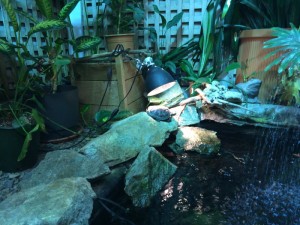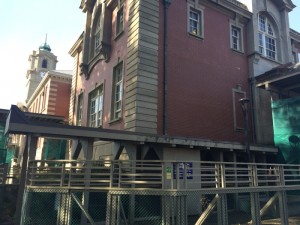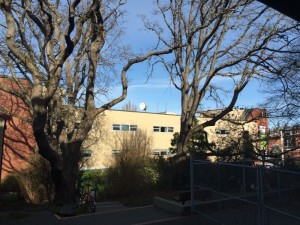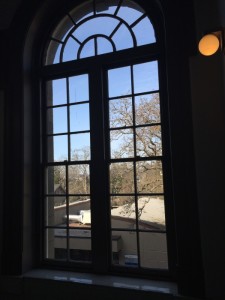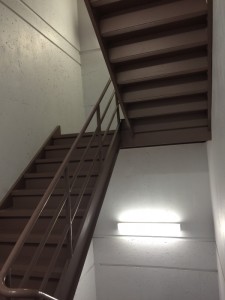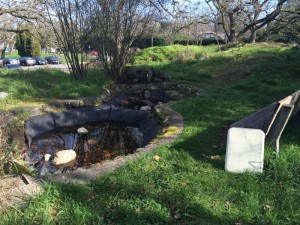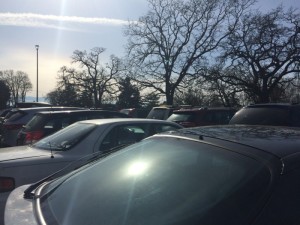Camosun College opened its doors in 1971; in the past 45 years, countless students have roamed the halls and fields of the Lansdowne campus. During that time, stories have been told and myths have blossomed: tales of, for example, ghosts, underground tunnels, and, uh, turtles. Naturally, there are lots of unanswered questions, and we’re here to answer them.
Some of the buildings students walk in (with bags heavy enough to give them chronic back problems later in life) have a story worth telling. Full-time students probably spend more time around campus than they do anywhere else, so we wanted to give students a chance to get to know their home away from home.
We’re going to be doing this for Interurban, as well; if you have any tips about interesting and unknown aspects of that campus, email editor@nexusnewspaper.com today to let us know.
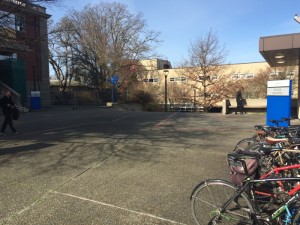
Let’s go underground
Next time you’re walking between Ewing and Young, stop for a second and look at the ground. What you can’t see is that underneath the concrete there is a tunnel connecting the two buildings. It’s not exactly a decorative feature on campus, but Camosun supervisor of building services Graham McKinnon says that it’s been in use since Ewing was built, in the 1960s.
“It’s used for services,” says McKinnon. “The heating water for the boiler runs through the tunnel; that’s the heating for Ewing as well. Then we’ve got domestic hot water that goes over there, too, and then there’s some electrical pipes as well. There are all sorts of different services that go through there.”
If you’re thinking of going on an adventure, you’re out of luck (uh, not that we tried, really): it turns out the tunnel is only accessible to workers through the Young boiler room. And it sounds like getting through it is quite an adventure.
“You could physically get through it,” says McKinnon. “It’s not like it’s just big enough for the pipes; you can walk through it. From Young, you’re standing up, and then you can walk probably three-quarters of the way down, and then you’re kind of on your hands and knees, but you can get over to Ewing.”
McKinnon says there has never been a serious incident regarding the tunnel in the 18 years he has been working at Camosun, and he answers the question on everyone’s minds: no students have ever been stuck in it.
Is that… a turtle… in Fisher?
Yes, you read that right: there is a live turtle in the foyer of Fisher, outside the cafeteria. The turtle must like watching the world go by from the cozy confines of Camosun’s little indoor pond. Well, we’re guessing that the turtle likes it; we really have no idea.
Arts and Science student Navjot Singh says it’s nice to see a turtle there on his way to class.
“That’s not a bad thing. We feel good. We’re just going by the Fisher building and we just see a turtle there. It’s a good thing. We are not hurting them.”
Many students were shocked that a turtle was being kept inside the school, but first-year Social Work student Sydney Cordero says it is okay, as long as the turtle is “tended to regularly.”
“I don’t know its real living conditions,” she says.
We can reveal that its real living conditions are not the inside of a college in Victoria, BC, but it appears that the majority of students are okay with a turtle keeping an eye on the happenings of first-floor Fisher (Camosun does ask that people do not throw coins or other objects in the water, for the health of the turtle). Oh, and the turtle’s name? Bubbles.
A hospital on campus
It might be covered in scaffolding and best approached with a hard hat these days, but the Young building is actually a historical monument, and it’s right here at Camosun.
“I heard it was an old school, and then a hospital,” says Singh. “It was used as a hospital during the war.”
It’s true: what is often regarded as the nicest building at Camosun was once used to treat wounded soldiers who had returned from the war. Next time you’re sitting in Young stumped on a multiple-choice question and wishing you didn’t have to sit in front of chalkboards all day, try imagining some soldier lying there all wrapped up in bandages. Maybe class isn’t so bad.
“It’s cool that we have something historical on campus,” says Early Learning and Child Care student Tatianna Mattrick.
Cordero agrees, adding that it’s good that it’s still being used.
“It kind of serves as a monument, and that in itself is pretty cool that we haven’t demolished it.”
The secrets on Fisher’s roof
It’s not exactly in your everyday line of sight at campus, but there’s a weather station on campus; it lives on the roof of Fisher. According to Camosun Geography and Environmental Technology instructor Chris Ayles, the data it gathers are transmitted wirelessly to the geography classroom. Camosun then sends the data to UVic, where they are posted on the school-based weather network. But don’t think just being a Camosun student gives you access to the weather station.
“The students who want to work directly with the weather station need to take one of my classes in Environmental Technology or Geography,” says Ayles.
With a station set up on a roof comes unique problems, which Ayles knows all too well. “I had to replace it recently because it broke,” he says. “Sometimes the wind knocks it over, which is kind of sad. Some workers took away the cinder block that I had holding down the base.”
Most students don’t know such a station exists at Camosun, and reaction is mixed on whether it’s a good use of money and resources.
“If it’s put toward certain programs, maybe,” says Cordero. “Otherwise, not so much. It’s just information for them.”
“It’s good to know about the weather,” says Singh. “It’s not a waste of money.”
The ghosts of exams past
Some people roll their eyes when they hear the words “paranormal activity,” but others are not surprised to hear that some of the patients from when the Young building was a hospital might still be roaming the Young halls.
Second-year English student Chad Hartley says he has a friend who is a former Camosun student who swears he saw “a white mist shape close a door at the end of the hallway” on one of the floors of Young.
Singh prefers logical explanations to the possibility of ghosts in Young.
“Students are always coming in and out of there; even in the night there are classes. Come on. If it were haunted, it would be haunted 24 hours a day. Why only night? That would mean that the ghosts always have a watch.”
Cordero is not so sure, but she does not shoot the idea down entirely.
“I’m not in there too much, but I don’t think I’ve ever seen any paranormal activity there. It would be cool, though.”
Either you want to believe that some old war vets are still in Young, watching us all go about our days, or you don’t. But if you’re curious, go for an evening stroll in what is possibly Camosun’s most haunted building, and let us know if you come across anything otherworldly (hop on over to the Richmond House for an extra dose of ghostly activity; there has been much alleged paranormal activity in the building on the edge of campus over the years).
Sneakin’ smooches
It’s nice to stop for a breather during the hustle and bustle between classes, but in this case, it’s not to marvel at the historic beauty of the school. To be frank, it’s nice to sneak a smooch in sometimes. And Lansdowne’s got a ton of good spots to do just that.
Students we spoke with said that some of the best spots to get some lovin’ are Fisher’s stairwell and the main grassy area in front of Young.
Back at the Nexus office, managing editor Greg Pratt says that while he would obviously never encourage such behaviour, he does remember his time at Camosun being punctuated with a smooch in, yup, the Fisher stairwell, and that story ended well: the recipient of that kiss so many moons ago is now his wife. It’s a Camosun love story, and one that doesn’t just involve manic, hushed groping in the library.
What shape is the pond?
Wait, we have a pond at the Lansdowne campus? We sure do, and it’s in the shape of a figure eight.
Numerous plants and shrubs grow around this totally hidden feature of Lansdowne, and there’s also a bench to sit on and enjoy some peace and quiet if you do decide to track this spot down.
So where is it, exactly? The pond is located in the Garry Oak patch behind the Wilna Thomas building. If you’re feeling overwhelmed with your workload, or in need of a quick catnap in the spring semester, this is a perfect secluded place to catch your breath. Or at least it was, until we went and told everyone about it. Oops.
Parking problems
In a recent issue of Nexus, Camosun student Thomas Nicolson called parking fees “more of a stab in the face” than tuition fees. Sure, even though gas prices are comparatively low now compared to how they have been in recent months, having a car is a luxury that many students simply can’t afford, and parking just adds to the financial strain.
Robbins Parking is the company that takes our cash for the privilege to park at various spots throughout the city, including the college. So where does all your parking money go to? At Camosun, Robbins’ cut is less than 12 cents of every dollar students spend on parking. Five cents goes toward student U-Passes, and 83 cents goes toward education and student and administrative services.
University Transfer student McKenzie Loggin thinks student complaints about the parking prices are “pretty warranted” but says that it’s one of the things the college just “needs to do.” (Both Camosun College and Robbins Parking declined to speak with Nexus about parking on campus for this story.)
“I think it’s one of the things that they can probably capitalize on, because students have to find a way to get to school,” says Loggin. “It’s not like they can really not come to school; for a lot of people it’s a large commute, so I think it’s probably their way of saying, ‘Okay, this is something we need to do, so we could probably amp up the prices.”
Buttons on the walls
I know, I know: you see a button and it’s really, really hard to not press it. But these aren’t for fun and games. The emergency buttons at designated spots around campus are part of the Walk Safer program at Camosun. If you’re not sure about walking back to your car after a night class, or any other time, these people will give you a ride to make sure you get home safe. Thankfully, says Camosun security, there has never been a serious incident on campus where someone in need of help has pushed the button.
If you’re ever feeling on edge after a night class, hit the button, wait for their arrival, and hop on the back of the Walk Safer golf cart; they’ll give you a ride right to your car.
Minkyu Lee, a first year Computer Science University Transfer student, says he’s never seen a dangerous incident on campus. “I haven’t seen anybody using it.”
Buyback blues
Textbooks are one of the biggest thorns in the sides of students, whether it’s reading them, buying them, or reselling them. When it comes to trying to get rid of them, many students simply post what they’re selling at the end of a term on Facebook, or linger outside the bookstore at the beginning of a term. Either way, the fact of the matter is that selling your used textbooks is a pain.
Despite the fact that students are often told they will be able to resell their readings, many do not see a cent back for their books. The bookstore can’t sell anything that is deemed outdated. It also won’t buy books if the course isn’t being offered within a certain time frame. Much like smartphone updates, new editions come out faster than students can buy them; sometimes there is only a page or two that is slightly different, but it’s enough of a difference to be denied resale on a technicality.
As frustrating as those technicalities are, many students who can’t afford textbooks will be more than happy to take one that the bookstore can’t. Take a look through the readings. If the differences are minute enough, some less-by-the-book students would be happy to take it off your hands to save some money.
Sometimes a course finishes and is not offered again until the spring or fall, by which time there will more than likely be a few changes, but be patient. One person’s trash is another’s treasure.

